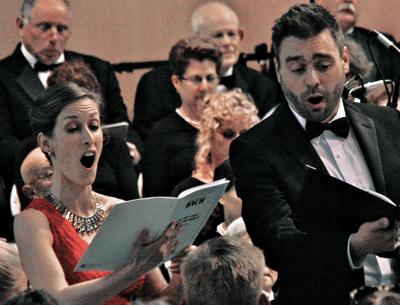Opinion: Vibrant Performance Of Masterpieces

The Choral Society of the Hamptons joined with the Greenwich Village Singers and the South Fork Chamber Orchestra on Saturday evening to fill the Parish Hall at Most Holy Trinity Catholic Church in East Hampton with the glorious sounds of masterpieces by Johann Sebastian Bach and George Frideric Handel, composers who brought Baroque music to its peak.
Bach’s Cantata “Gott, der Herr, ist Sonn’ und Schild” (BWV 79) opened the program with a flourish. Originally written for the 1725 Lutheran Reformation Festival at St. Thomas Church in Leipzig, the piece immediately achieves a celebratory mood by juxtaposing two horns against a rather jaunty countermelody in the strings and oboes. Under the clear and amiable direction of Mark Mangini, the South Fork Chamber Orchestra skillfully laid the foundation for the first thrilling entry of the chorus.
In each of the choral movements of the cantata, the Choral Society and Greenwich Village Singers demonstrated a delightful combination of vigor and dexterity.
The singer’s careful preparation was evident in the clear German diction, accuracy of entrances, and precision of consonant placement. This attention to detail helped to clarify the architecture and message of the music for the audience and freed the singers to express their joy at engaging with such finely crafted music.
Whether navigating adroitly through a fugue or joining to offer a chorale, the chorus sang with beautiful tone and confident intonation. Mr. Mangini’s gestures during contrapuntal passages highlighted each appearance of the fugue subject: essential guidance for the performers, of course, but also helpful in directing the attention of the audience to each recurrence of the main theme.
The cantata’s second movement features an aria for alto, brought pleasantly to life by Suzanne Schwing amid the delicately dancing ministrations of the principal oboist, Hugo Souza. Sara Paar and Mischa Bouvier were quite expressive and enjoyable to hear in the duet for soprano and bass in the fifth movement.
Mr. Mangini and the South Fork Chamber Orchestra — a roundup of accomplished professionals from all over Long Island and beyond, which springs into existence whenever needed for a Choral Society concert — then presented the fourth movement of Bach’s Brandenburg Concerto No. 1. They did an excellent job with this challenging work. There was not a weak player among them, but special regard is due to the horn section. The tessitura of the horn parts in Cantata 79 lies quite high in the range throughout (especially on modern instruments), while the first horn part in Brandenburg No. 1 is stratospherically virtuosic.
Thanks to the principal hornist, Luiza Raab-Pontecorvo, and her colleague, John-Morgan Bush, no one listening had any idea that the horn parts were an unusual challenge. They made the job seem easy.
English oratorios as a genre show that necessity is often the mother of, if not always invention, at least innovation and exploitation. With the Church proscribing licentious and pagan entertainments like opera and theater during Lent, Handel successfully adapted the Italian oratorio model to the English language and public. Eliminating sets, costumes, and staging, and using Biblical story lines instead of pagan mythology, allowed creators of oratorio to work around the Church’s objections, while still providing audiences with dramatic musical settings of compelling stories.
Saturday’s concert presented the central, dramatic portion of Handel’s “Israel in Egypt.” While an oratorio, like an opera, normally alternates between choral and solo or small group textures to tell its story, “Israel” employs the chorus as narrator nearly all of the time. Ms. Schwing returned for the alto solos and Gregory Mercer, a professional who also sang with the tenor section for the oratorio, delivered the two recitatives quite vividly.
In fact, the whole piece is vivid: After all, the text and music portray the plagues visited upon Egypt before the Exodus. Handel clearly had a lot of fun writing musical figures to illustrate bloody rivers, flies and lice, fiery hailstones, and, especially, the blindness that comes with overwhelming darkness. The singers, divided into two separate choruses, handled these images in a way that showed they relished the chance to communicate such rich text painting.
During the final movement, while singing enthusiastically of how “the horse and his rider” had been “thrown into the sea,” it seemed that one or more tenors were not far from breaking into a dance upon Pharaoh’s grave. Throughout all the choral movements, the singers maintained an impressive level of commitment to precision in attacks and cutoffs as well as clear articulation and animated interpretation of the text.
In the eighth movement, the tenors were first to introduce a rangy and angular fugue subject on the text “He sent a thick darkness over the land. . . .” At this highly exposed moment (and once more in another movement) the blend in the tenor section became suspect as individual voices became more prominent on certain notes. However, this was an aberration in an otherwise solid performance from the section.
That some difficulty arose among the sopranos of chorus one to keep to tempo in the melismatic passages of the final movement was surprising. However, the concert called for a lot of singing from the chorus, and despite having sung a rehearsal of the program earlier that day, the singers maintained fantastic vocal and facial energy all the way through the final cadence.
It was a privilege to experience the incredible collaboration of so many singers and instrumentalists as they reinvigorated musical works whose pedigree is centuries old. Congratulations to all involved in sharing with the East End community such a vibrant, impressive display of talent and musicality.
